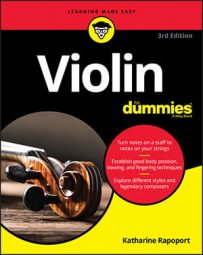Now that you’re up and running with your violin (just don’t sprint too fast — you might drop it!), you can look beyond traditional teaching out into the big, wide world.
Subscribe to a magazine
A fun and easy way to keep up‐to‐date on musical topics is by subscribing to a magazine, where there’s certainly plenty of info to interest you. Here are some good music magazines:
Attend concerts
For the most part, today’s concerts are geared more toward a variety of audiences. In one season, orchestras usually schedule several different series to suit all kinds of tastes. And most orchestras also schedule Sunday afternoon concerts, which are great if you have a long way to drive to get home, or if you can’t come out in the evenings.
Join a community orchestra
Even if you haven’t been playing long, you may be able to join an orchestra in your area. Some community orchestras are at a semiprofessional level and expect players to have several years’ experience. But many local orchestras welcome string players of all levels. Ask about opportunities at your music school, community college, or university.
Go to summer camps
Nowadays, summer camps aren’t just for children. Many camps are geared to young professionals and advanced students.
Camps vary widely in programming and accommodations. Look at brochures and websites for details before you apply. Costs differ quite a lot between camps, depending on the amount of individual instruction and the accommodations, but these recent ranges give you some idea:
Blue Lake: About $250 (U.S. dollars), including the registration fee, for a specialty four‐day adult string orchestra session. Players can stay at the campsite or find their own accommodations in nearby hotels or motels.
CAMMAC: About $550 for a week’s instruction. Lodging and meal costs are extra and depend on whether you camp or stay in the main building, and so on.
Play in small groups
From very early on in your study of the violin, you can begin to play in small groups. Good avenues for finding a group could be via your teacher, people at a local music store, or contacts at your church, community center, or workplace.
Check out the following publications for information about organizing small ensembles or for playing with a pianist friend:
Folk Strings, More Folk Strings, Festive Strings, and More Festive Strings (Alfred Publishing), all by Joanne Martin
Violin Series, 2013 Edition (Frederick Harris Music), by The Royal Conservatory of Music
Suzuki Violin School (Alfred Publishing)
Participate in festivals
A festival is an occasion to celebrate and be, well, festive. So you can be as enthusiastic as you like! You can participate in festivals in two ways: as a player or as part of an audience.
Local music festivals (competitive and noncompetitive)
Local music festivals provide opportunities for performances of all kinds, from music to ballet or even acting. Music festivals are geared mostly to kids, but they often include classes (festival‐speak for a “section”) for adults or classes where families can perform together. Usually, these classes are noncompetitive and light‐hearted affairs, meant for fun and the enjoyment of playing.
International music festivals
International festivals offer an opportunity for you to be in the audience to hear some great performances by seasoned artists. Bigger festivals centered around concerts or operas happen in all kinds of places, so you can connect with one that seems attractive to you. Many festivals, big and small, happen all over the world, and with Internet access, you can check out the ones that interest you.
Build a music collection
A trip to any record store or music website offers you a huge selection of CDs or digital recordings. At first, choosing one or two CDs or downloading a few tracks featuring your favorite composer or violinist is a good start and makes for very enjoyable listening.
Check out these links for music reviews and recommendations. Or just browse to see what’s available:
Watch and collect videos and DVDs
You can find out so much from watching other violinists play their instruments — and how much you’d enjoy seeing your own home “concerts,” performed by great artists. A trip to the local library may give you access to classical music performances on DVD that you can borrow. Otherwise, you can head for a well‐stocked music store to check out what’s available, or look online at the big specialty retailers’ sites.
Nowadays you can also visit YouTube to access all kinds of live performances, even by piano‐playing cats!
Just to get you started, here are a few suggestions:
The Art of Violin (NVC Arts)
The Red Violin (Universal Studios)
Music of the Heart (Miramax
Stradivari (Beverly Hills Video
The Art of Henryk Szeryng (Video Artists International)
Gil Shaham Mozart Violin Sonatas (EuroArts)
Visit competitions
Violin competitions draw some of the finest young players from all over the world. These players are all hoping to win and carry off both the financial prize and the concert engagements that go with winning. You can hear some truly wonderful playing in competitions.
The most famous violin competitions, where many winners have continued on to significant careers, are the following:
Queen Elizabeth Competition, Brussels
International Tchaikovsky Competition, Moscow
Wieniawski Competition, Warsaw
Indianapolis Violin Competition
Perform at hospitals and seniors’ homes
After you have some tunes under your fingers, what better way to share the music than to visit a hospital or seniors’ home? Most facilities have an events organizer, who’s your first contact in setting up a visit. Make your first visit short and sweet, just two or three songs is plenty. Then, if you like the idea and the audience enjoys the music, you can decide what else you have to offer.

